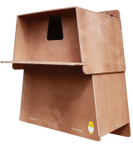![16S Schwegler Swift Box (with Starling Barrier) 16S Schwegler Swift Box (with Starling Barrier)]()
Click to have a closer look
About this product
Specification
Customer reviews
Related products
Recommended products
About this product
This is a variation on the higly successful Schwegler Swift Box 16, and features an in-built barrier to exclude Starlings. This Nesting box is for installation on or in external walls. Where insulation is included in the facade the box can also be inserted into the insulating layer. The box has a built-in starling barrier at the entrance as an effective means of preventing starlings from occupying the box.
Why is it necessary to exclude starlings?
Firstly, no one who is seriously concerned about the protection of bird species has any objections to starlings - quite the contrary. In designing starling barriers the intention is to assist the protection of all species ( nest boxes specifically for Starlings are also available). However, we have to accept that starlings can present a problem when they nest on buildings, usually because of the mess that they make on and around the building, for example on "prestige" buildings or in areas used by the public. This often results in a reduction in the number of nesting aids for swifts, which in turn means that less breeding areas are available for them. Where nesting boxes are occupied by swifts their habits definitely do not result in the fouling of buildings. Selective projects for monitoring swifts have shown how welcome this starling barrier is as a means of reducing unwanted occupancy.
How the starling barrier operates
The anatomy of the starling (long legs etc.) prevents it from getting through the barrier and into the brood chamber that lies behind it. Swifts have very short legs, enabling them to easily gain access through this tunnel. Tests conducted over many years have proved the effectiveness of this system.
Installing the barriers in existing boxes
As a rule, barriers should not be installed in existing brood boxes because the swifts enter the box at a high speed and can injure their beaks. It is well known that when swifts return to their previous year's sites they tend to fly "blind".
Installation: 2 recommended forms of installation:
1. Set into the external facade.
Can be bricked in or installed in the facade. Flush mounting is also possible. If the wall includes insulation the box can also be built into the layer of insulation.
2. On or in the outer surface of the facade.
Surface mounting is also possible, for example on house walls. When set into an external wall the box also can be painted with standard air-permeable external wall paint.
Height and direction: the entrance hole should be located at least 5 m above the ground. Please ensure that birds entering and leaving have unobstructed access. The installation of several of these nesting aids in each building will help the rapid formation of colonies of swifts.
Cleaning and inspection: for inspection purposes the front panel, with a device to prevent occupants from falling out, can be completely removed. Cleaning is not necessary, if occupied by Swifts.
Specification
- External dimensions: 42 x 22 x 24 cm (L x W x H)
- Interior dimensions of nesting chamber: 36 x 16 x 17 cm (L x W x H)
- Entrance hole dimensions: 103 x 35 mm (L x W)
- Weight: approx. 12 kg
- Material: Air-permeable Schwegler wood concrete
- Colour: Light grey, main box coated, natural grey front panel
Customer Reviews





































